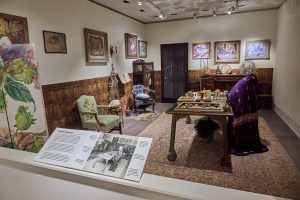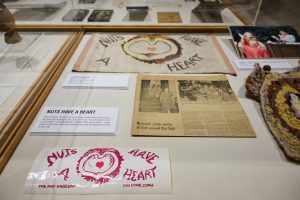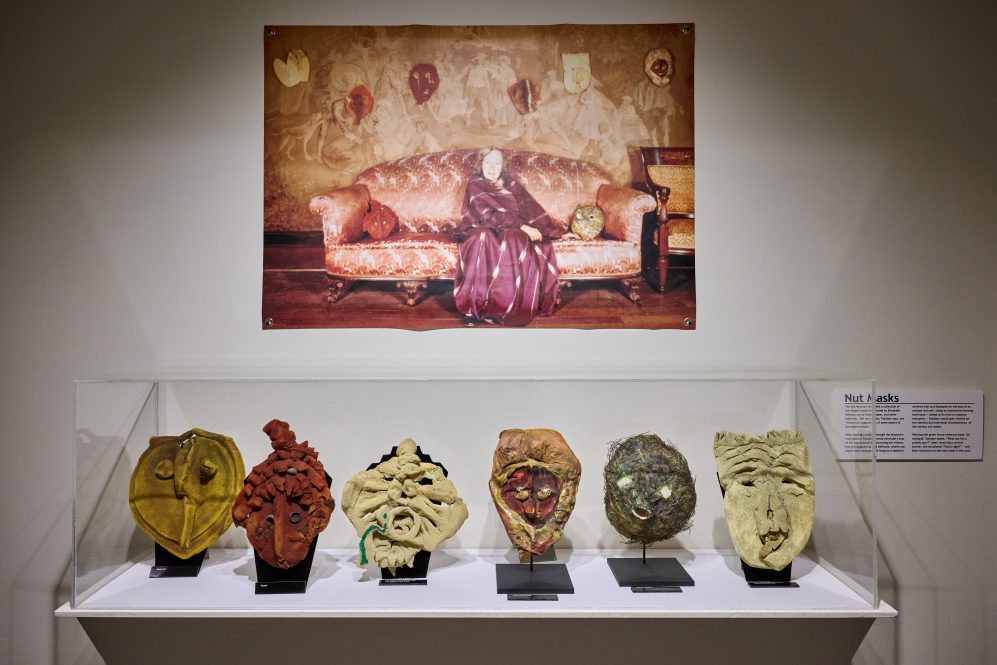Fifty years ago this spring, Elizabeth Tashjian opened her Old Lyme home to the public as a museum dedicated to nuts – chestnuts, almonds, coconuts, pecans, hazelnuts, acorns, all things nuts.
Today, 20 years since its closure and 15 years since her death, The William Benton Museum of Art is “Remembering the Nut Museum” in its latest exhibit that showcases Tashjian’s fascination and love of, if not obsession with, nuts.
“When I teach museum studies, I use Elizabeth’s collection as an example of a modern cabinet of curiosities,” says Christopher B. Steiner, art history and anthropology professor at Connecticut College. “In the Renaissance there were these cabinets of curiosities in which people would collect odd things that nobody had ever seen – a new species from the New World or from Africa, rare shells, and that kind of thing. I see Elizabeth’s collection as being part of that vein.”
The Benton’s exhibit, which Steiner curated, wouldn’t fit into a modern-day cabinet, though, as it features four dozen of Tashjian’s major paintings, a recreation of the Nut Museum’s main exhibition space from her home, sculptures, a case of homemade masks, and an assortment of other treasures from the trove recovered from her home in 2002. Her prized 35-pound coco de mer, from a palm tree on one of the islands of Seychelles in the Indian Ocean, is placed where it always was kept – on a Chinese mahogany chair in Tashjian’s recreated dining room.

She operated the Nut Museum for 30 years, welcoming young and old into the first few rooms of the home she inherited from her mother as an only child. She’d give visitors narrated tours, complete with made-up songs, Steiner says, in a form of performance art. Gaining the attention of Johnny Carson, she twice visited “The Tonight Show,” later appearing on TV and radio with Jay Leno, David Letterman, and Howie Mandel. The cost for entrance to her museum was one nut.
“There is this tradition in American museums of these quirky, eccentric, off-beat museums, and there’s a following out there of people who want to go to these places,” Steiner says. “A lot of times they’re also linked to roadside attractions. People drive across the country and stop at the Biggest Ball of Twine, the biggest pencil in the world. I don’t think that would have been Elizabeth’s choice; I think she thought of herself as an artist, having trained in her youth at the National Academy of Design in New York City. But she ended up being lumped into these tour books of weird roadside attractions and that’s where a lot of her audience came from.”
At 90 years old, she was found in a coma in her home and wasn’t expected to survive. Without heirs and in debt, the home was bound for town acquisition and its contents to be sold when Steiner petitioned for the art and contents of the museum, he says. Their ownership was granted to Connecticut College, where Steiner has used it for teaching and brought it out for exhibit in 2003, 2004, 2019 – and now for its anniversary.
“These off-beat museums tend to be run by one person, and when that one person dies or when circumstances put an end to the museum, a lot of times they disappear,” he adds. “They’re very ephemeral and this was just a great opportunity to save it.”

Tashjian woke up after three weeks in a coma and spent her remaining years in a nursing facility in Old Saybrook. That’s when Benton Executive Director Nancy Stula met her.
“She was a character,” Stula says. “I didn’t get to know her as well as Chris did, but I can appreciate what she was doing with her collection. Her cabinet of curiosities is worthy of display and study through the lens of passion, obsession, and collecting, along with issues confronting the elderly. In bringing it to the Benton Museum of Art, I thought it would be interesting to explore these points through the exhibition. As Connecticut’s state art museum and UConn’s art museum, we have a broad audience to serve.”
Steiner is writing a book, “Performing the Nut Museum,” and says he hopes another venue could take over as caretaker of the collection. “In an ideal world, it should go to the Smithsonian Museum of American History, because she is part of American museum history.”
The William Benton Museum of Art will hold a series of events around “Remembering the Nut Museum,” including a gallery talk by Steiner on Feb. 17 and a screening of the Don Bernier film “In a Nutshell: A Portrait of Elizabeth Tashjian” on March 1. An interactive workshop on Collecting in Practice will be held March 8. All the events will be held via Zoom.
“Remembering the Nut Museum” will close March 11. For event details visit Benton.uconn.edu.



